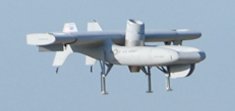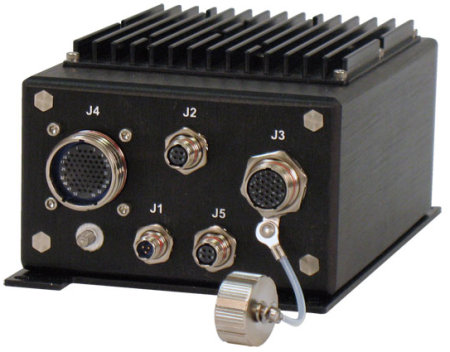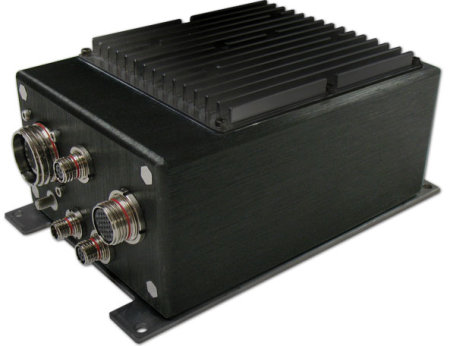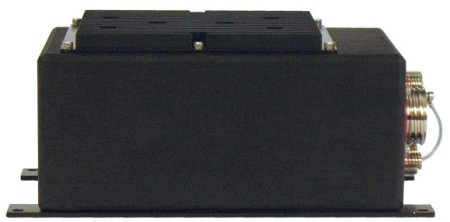Drone takes wing with Linux PCs onboard
Aug 18, 2009 — by LinuxDevices Staff — from the LinuxDevices Archive — 9 viewsParvus Corporation has announced a successful test flight for the Aurora Excalibur, an unmanned attack drone using two Linux-based DuraCOR 820 embedded PCs. Offering autonomous vehicle management and flight control, the Excalibur allows operators to focus on mission objectives, according to the company.
Parvus says the Excalibur UAV (unmanned aerial vehicle) — developed by Virginia-based Aurora Flight Sciences Corp. for the U.S. Army Aviation Applied Technology Directorate and the Office of Naval Research — weighs just 700 pounds, allowing troops to carry it with them into the field. The drone needs no runway, the company adds, because its jet engines and electric lift fans provide it with VTOL (vertical takeoff and landing) capabilities.

The Aurora Excalibur
Once in flight, the Excalibur can reportedly hit 400 knots (about 460 miles per hour). The drone's deadly intent is underlined by the fact that it's said to be capable of carrying a 400-pound weapons load, such as four Hellfire missiles. In addition to "quick-response weapons delivery," the drone can also perform "logistics resupply from remote, austere forward operating bases or from air cable ships operating in the littorals," Aurora says.
According to Parvus, the Excalibur flew earlier this month with two Linux-based ACMC (Aurora Common Mission Computer) units onboard, each based on the company's previously released DuraCOR 820 tactical computer (see below for details). While Parvus was not specific about the purpose of the onboard PCs, they apparently are part of the Excalibur's "fully autonomous vehicle management and flight control systems." The drone is said to be capable of flying itself, allowing ground-based operators "to focus on mission objectives."
Les Goodman, president of Parvus Corporation, stated, "Parvus has a long history of successfully supplying key military contractors, such as Aurora, with advanced MIL-grade Commercial-Off-The-Shelf (COTS) computing solutions tailored to specific UAV platforms. The Excalibur will prove to be a valuable aircraft to the military's arsenal of UAVs and Parvus is honored to participate in this important program."
The DuraCOR 820
Designed for space/weight-constrained military/aerospace deployments, the DuraCOR 820 Small Tactical Mission Computer measures 7.0 x 4.3 x 3.0 inches and weighs three pounds. It's based on a conductively cooled Intel Pentium M738 clocked at 1.4GHz, which offers performance equivalent to a 2.8GHz Pentium 4, Parvus says.
The computer ships with 512MB or 1GB of memory, while Linux is stored on the system's 2GB of flash memory. The system offers two Ethernet ports, three USB 2.0 ports, two serial ports, and other assorted I/O.

DuraCOR 820
(Click to enlarge)
The DuraCOR 820 has been ruggedized with claimed compliance to MIL-STD-810F environmental conditions (high altitude, thermal, shock, vibration, humidity), MIL-STD-461E EMI/EMC levels, and 28VDC avionics power supply standards (MIL-STD-704E). The computer is said to support a wide range of field applications, including command and control (c2) on-the-move, unmanned vehicle operator control, and C4ISR situational awareness.


Side views of the DuraCOR 820
The following are the major specs for the DuraCOR 820:
- Processor — Intel Pentium M738 clocked at 1.4GHz, 2048k L2 cache
- Memory — 1024MB DDR-SODIMM; 2GB CompactFlash (upgradable)
- Video — VGA analog output
- Networking — 2 x 10/100Mbps Ethernet
- >Other I/O:
- 3 x USB 2.0
- 2 x RS-232 serial
- 4 x GP DIO digital inputs
- 4 x GP DIO digital outputs
- Expansion — 1 x CompactFlash (2GB card standard)
- Dimensions — 3.0 x 4.3 x 7.0 inches (75.95 x 109.22 x 177.8 mm)
- Weight — 3 lbs (1.36 kg)
- Chassis — corrosion-resistant aluminum alloy, anodized per MIL-A-8625, Type II, Class 2; flange mount baseplate
- Power — 9-32 VDC Input (28VDC Nominal); 22 Watts max dissipation; reverse, over voltage, surge protected; MIL-STD-704E compliant
- Temperature range — -40 to 158 degrees F (-40 to 70 degrees C); MIL-STD-810F compliant
- Humidity range — 5% to 95% (non-condensing); 100% (condensing); MIL-STD-810F compliant
- Operating shock — 15g, 15ms, 1/2 sine wave, 3 positive/negative per axis; MIL-STD-810F compliant
- Crash-safety shock — 40g, 12ms, 2 pluses per axis
- Random vibration — 0.22-G(squared)/10-Hz to 0.0026-G(squared)/2000-Hz
- EMI/EMC — MIL-STD-461E compliant
- Altitude — 60,000 feet (18,288 meters); MIL-STD-810F compliant
- Dust, water, and moisture resistance — IP65 and NEMA 4 compliant
- Operating system: Linux or Windows XP Embedded (120-day evaluation license)
The Aurora Excalibur's first test flight
Source: Aurora Flight Sciences (click to play)
Further information
More information on the Excalibur can be found on the Aurora Flight Sciences website, here. More information on the DuraCOR 820 can be found here.
This article was originally published on LinuxDevices.com and has been donated to the open source community by QuinStreet Inc. Please visit LinuxToday.com for up-to-date news and articles about Linux and open source.